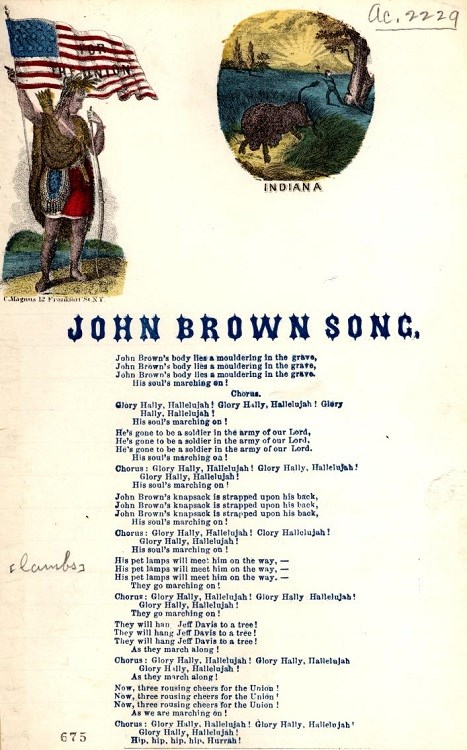Last updated: January 14, 2025
Article
The John Brown Song (John Brown's Body)
John Brown’s body lies a–moldering in the grave,
But his soul goes marching on. Glory, Glory hallelujah ….
First garrisoned in 1861, some of the first soldiers to arrive at Fort Warren on Georges Island came from the Second Battalion of Infantry. Tasked with cleaning up construction debris left on the island, the regiment sang to make the work go by faster. They sang popular songs of the time, which included a Methodist hymn called "Say Brother Can You Meet Us."[1]
One of these singing soldiers went by the name John Brown. Well liked amongst the soldiers, and known for cracking jokes, he could also take one. Others often teased him for sharing a name with the abolitionist John Brown. It is this teasing that led to the song that we know today as, "John Brown’s Body."

Library of Congress
According to the story, a group of soldiers arrived late to the bunks. They asked their fellow soldiers if anything new had happened. One soldier replied jokingly, "John Brown’s dead" to which another responded, in the tune of "Say Brother Can You Meet Us," "But his soul goes marching on."
The Second Battalion also trained at Fort Warren. It is said John Brown’s knapsack, much too big for him, looked silly when he wore it. The soldiers could not let a joke pass, and one announced, "John Brown’s Knapsack is strapped upon his back and his soul will march as far as any of you!" The first part of which remains a common verse in the song even today.[2]
Not long after the birth of the song, the Second Battalion disbanded. Some of the soldiers remained at Fort Warren and joined the 12th Massachusetts Volunteer Infantry led by Daniel Webster’s son, Colonel Fletcher Webster. Although disbanded, they continued singing the song and encouraged others to sing along.[3]
In the 12th Massachusetts regimental history, the author remembers how the regiment felt about the song:
The song originated with the Second Battalion of Infantry while it was in the fort; it had been enthusiastically adopted by the Webster Regiment. [4]
At one point, an officer suggested the name be changed to honor a colonel who had recently been killed in Alexandria. Others grew concerned that the song could be misconstrued as honoring the John Brown of Harpers Ferry. Despite these concerns, the regiment refused to change its name.[5]
After a long wait, in July of 1861 the 12th Massachusetts received their orders to go to the front lines. At a military parade several days before the regiment left Boston, they sang "John Brown’s Body" publicly for the first time. Though they returned to Fort Warren that night, they sang again as they left Boston. This continued as the regiment made its way south. In Baltimore they sang, in New York, they sang with a band. "Electrified" by the chorus, onlookers loved the new song. They had already been called "Webster’s Regiment," but by the time they finished, they also earned the nickname the "Hallelujah Regiment."[6]
In the crowd at one of their performances, poet Julia Ward Howe heard the song and grew inspired. Soon after seeing the regiment perform the song, she published the "Battle Hymn of the Republic," which is often sung to the same tune as the "John Brown Song" and "Say Brother Will You Meet Us."[7] The 12th Massachusetts engaged in heavy fighting in the battle of Second Bull Run, Antietam, Fredericksburg, and Gettysburg. By the time the 12th Massachusetts mustered out in 1864, they suffered many casualties. 840 of the 1040 of the soldiers that had left Fort Warren in July of 1861 never returned home again. This included John Brown, who by the time of his drowning early in the war had made Sergeant.8]
Footnotes:
[1] Jay Schmidt, "The John Brown Song." In Fort Warren: New England’s Most Historic Civil War Site, (Amherst, NH: UBT Press, 2003), 23-29.
[2] Schmidt, "The John Brown Song," 23-29.
[3] Benjamin Cook, eds.The History of the Twelfth Massachusetts Volunteers (Webster Regiment). Boston: Twelfth (Webster) Regiment Association (Boston: 1882, Twelfth (Webster) Regiment Association,12-13.
[4] Cook, The History of the Twelfth Massachusetts Volunteers (Webster Regiment), 22.
[5] Schmidt, "The John Brown Song," 23-29.
[6] Cook, The History of the Twelfth Massachusetts Volunteers (Webster Regiment), 21-25.
[7] Jack Doyle “The Curious History of The Battle Hymn of the Republic” Last Modified July, 2016, Accessed March 2023, Curious History of Battle Hymn of the Republic, "History of "John Brown's Body" PBS. Public Broadcasting Service. Accessed May 5, 2022.
[8] Cook, The History of the Twelfth Massachusetts Volunteers (Webster Regiment), 142-143.
